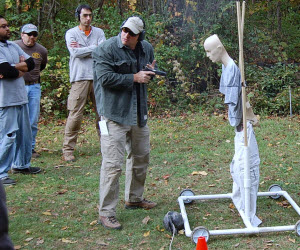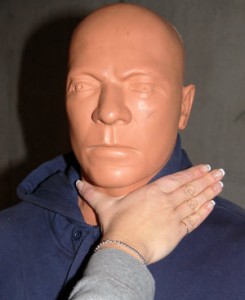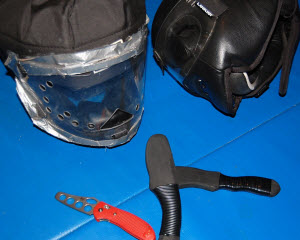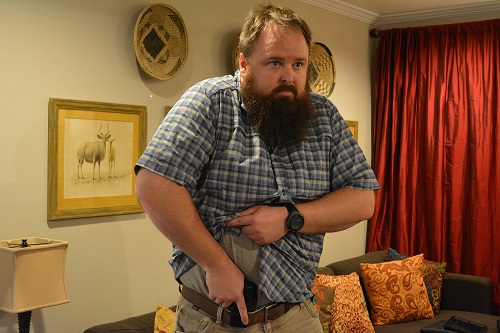A skill is something that requires training and experience to do well. Training is the acquisition of knowledge and skills. Practice is the repetition of a skill in an effort to get better and integrate the specific skill so it can be called upon when needed. Reading an article or viewing an informational DVD provides us with knowledge on a specific subject; neither translates to the acquisition of a skill.

Attending a training class provides you with knowledge, but then it’s your responsibility to practice what you’ve learned.
Personal-protection proficiency may include a variety of skills: shooting, edged weapons, empty-hand fighting, and general physical preparedness all require more than simply attending a weekend class or seminar. If the ultimate goal of personal-protection training is to have the ability to draw upon a certain skill at a moment’s notice during a critical incident, then practice of the newly acquired skill is essential to proper integration and the ability to recall that skill or skills.
What To Practice
For years, I’ve been told via martial arts and other training that “practice makes perfect.” Practice also makes permanent and, as one of my instructors sums it up, “Perfect practice makes permanent.” Sadly, it has been my experience that few know how to actually practice what they have learned at a training class or event. Designing a personal practice routine or schedule can be challenging, especially in the realm of personal protection, which consists of multiple skills. Simply going to your Karate or Jiu-jitsu dojo twice a week is not enough.
Selecting what to practice is based heavily upon individual needs and circumstances. For example, my friends in the U.K. are very limited because guns and knives are banned there. So they spend the majority of their time practicing unarmed combatives and improvised weapons.
Your situation may be unique as well. A basic rule of thumb is to work first on the skills you’re not so good at. If you’re a black belt in Karate, maybe it’s time to devalue that area of training and focus more heavily on shooting or edged-weapon training. You may be a great shooter but have little or no unarmed combatives skills. Don’t practice what makes your ego feel good but what makes you better and more prepared.
Periodization
Adapted from the fitness world, periodization is an organized approach to training that involves progressive cycling of various aspects of a training program during a specific period of time. Athletes have various skills they need to train to be competent at their specific sports: strength, speed, endurance, agility, flexibility, etc. Similar to personal-protection training, it is difficult to train all these skills at one time or in one practice session.
Periodization allows us to select a skill and focus our efforts on improvement in that area for a pre-designated amount of time. An easy way to approach this is to assign days, weeks or months to a specific skill. For example, Monday and Wednesday are for unarmed combatives training, Tuesday shooting at the local defensive pistol league, and Saturday/Sunday any other skills requiring maintenance.
Or the first week of the month is for firearms, second week edged weapons, third week unarmed combatives, and in the fourth week a day is dedicated to each. If one skill is really lacking, a month or more dedicated to that specific area may be necessary, with one day each week utilized as a maintenance day for other skills.
These are examples, not prescribed programs. Play around with your schedule and periodize your training to better round out your fundamental skills base and improve on weaknesses.
How To Practice
There are five key elements to designing a personal practice routine:
- Organization: Decide what you need to train and when. Arrange schedules to allow time for practice. Assemble any required equipment, training aids, or partners ahead of time. Don’t wait until the last minute.
- Discipline: Stick to your schedule no matter what. If you have to get up an hour earlier or go to bed an hour later, make arrangements to do so. Successful people possess the willpower and discipline to do what needs to be done to improve.
- Sacrifice: You may have to miss some sleep, the latest game on TV or a weekly shooting event with friends to focus on a skill that needs work. You may be uncomfortable starting at the bottom as a “white belt,” or sore and tired from hard training. Accept it and move on. Becoming proficient at something takes hard work, and hard work often involves sacrifice.
- Single or Multi-Skill Sessions: While most formal classes focus attention on one particular facet of personal protection, such as a weekly Krav Maga class, your individual practice sessions can combine multiple skills into one session. For example, you may need practice improving your handgun drawstroke, so incorporate a fixed-blade or folding-knife draw every other repetition. That way you’re getting practice with both tools and maximizing time efficiency. Multi-skill practice is only limited by your lack of ingenuity.
- Ingenuity: Practice can be an hour or simply ten repetitions of a given skill whenever time allows. For example, if you need work on your jab-cross combination, practice on the elevator, while waiting for the kids, or before bed. A few reps or a few minutes of dedicated practice every day add up quickly over time.
Conclusions
Identify what you need to work on, get organized, be disciplined, sacrifice some time and energy, and use your imagination to become proficient or better than you are today. Practice doesn’t have to be formalized like at the dojo, gym or range. You can practice at home, in your office, garage, at the park, or on a break at work. Remember that small bits of time add up and pay huge dividends on your hard work over the long term. The best IDPA shooters, top martial artists, and Filipino blade masters didn’t get where they are because of luck. They got there through hard work and skillful practice.



This is it! you have hit the nail right on the head. Since 1973 this has been my routine. I have found that having a set of dumb bells, heavy bag, Air soft guns and so forth right at home have been the key to keeping in the mix. It does not hurt to have an understanding wife and children that train as well. I have always lived on the edge of the city and have been blessed with friends that pop in to train on a regular basis. Only once was I accused of running a ninja death camp which lead to a comical introduction to the local swat officer and some new training members.
A very good article with a ton of tips and ideas I can actually use immediately.
There are times I feel like the Devil's Advocate. This is one of many. Personal defense - in my devilish view - is like women beauty. We men are provided with certain "gifts" and all can improve on them given time, effort, instruction, education, etc. So it is with women. They are all are provided with certain "features" and those can be improved by cosmetics, diet, perfume, bras, hair color, shaving, etc. As we age; time, money and expectations move to different places. A 60 years old hip joint is not going to do things the same way it did 20 or 40 years prior. As I have yet not seen a 50 years old beauty contestant participate in any "regular" beauty pageant, I doubt many guys will have the sunny and springy disposition to do much "manual work" to stay current in hand-to-hand combat. (Sorry Special Forces guys, you are a minority and Mr. Calendar will get you too!) As time goes by I feel doing like those two old guys in the movie "Second Hand Lions". Sit in the front porch with a shotgun, enough ammo and a cool drink... or buy an old piston engine plane, rebuild it and crash it into a barn. I rather stay alert, avoid confrontation ( if I can) and use any time to get out my shots first. I am ready to answer to God, and God only. Uh... I am also working on staying alive some more years, though!